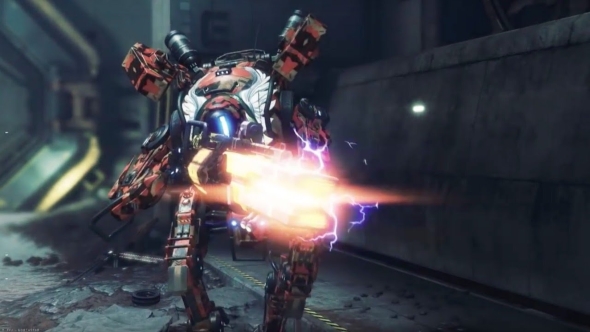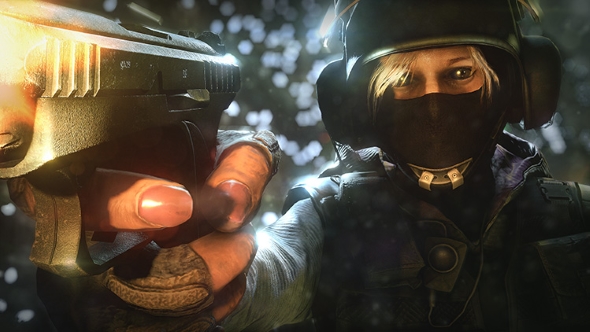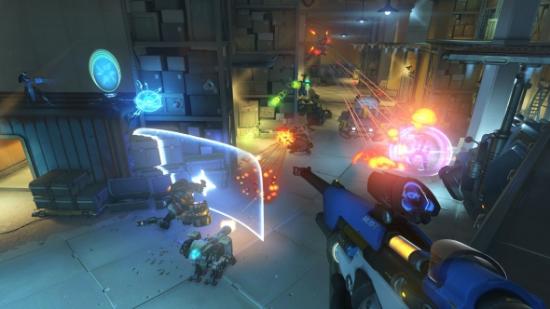Less is more, so the old saying goes. It’s something videogames typically aren’t very good at, with developers typically offering more choice, more collectables, and more padding with each new sequel and franchise. But 2016 has been surprisingly good for restraint in one genre: shooters. This year we’ve seen FPS games that keep things clean, cut-back, and are ultimately better to play.
There’s plenty of ways to play in our favourite shooters on PC.
I started thinking about this around the launch of Titanfall 2. Where in the previous instalment the titular Titans were fully customisable metal beasts, now they are set-in-stone mechs. You can’t mix and match chassis designs and choose from a tall stockpile of guns; each one is rigidly designed by Respawn. It’s something that had drawn the ire of some fans in the months leading up to launch.
It’s far from a problem though. Instead of a mish-mash of guns and gadgets, each Titan is an identifiable challenge. When you see a Northstar – a mid-sized Titan recognisable by its bunny ear-like rocket pods – you know exactly what kind of tactics to adopt. It uses a slow-firing railgun, so dodging is imperative. If one begins to hover it’s about to launch a barrage of missiles, so now is the time to shield up.

It’s these tells and guaranteed loadouts that make battle a more interesting prospect than just running and gunning. With the unpredictable nature of user-decided loadouts removed, you can hone and refine tactics to foil specific opponents. It’s all about discovering counters, and finding out which Titan is most effective against another.
The system also gives you the opportunity to master specific Titans. Rather than simply swap to a weapon that’s all-purpose and easy to use, to become effective you need to study and be proficient with every system a particular titan has to offer. Respawn have even scrapped the machinegun from the first game, removing the one spray-and-pray weapon and demanding players choose from a more considered, focused arsenal.
There’s a more obvious example of this than Titanfall 2, though. Overwatch is 2016’s king of ‘restrictive’ shooters, offering 23 characters each with just one weapon option each. If you want to play medic, you need to accept that you’re going to end up with Lucio’s weak Sonic Amplifier, Mercy’s slow-firing blaster, or Zenyatta’s weird bauble… things. There’s none of that Battlefield-style medic with a fully tricked-out M16 here.
By taking away choice when it comes to equipment, developers are empowered to make each individual player heavily focused on specific tasks. This is bolstered by strongly identifiable visual and audio design. So, for example, if in Overwatch you hear the chime of Torbjorn’s hammer – accompanied by his “Molten core!” shout – you instantly become aware of what’s going on. You can now effectively plan on how to take out his beefy quad-barrel turret, safe in the knowledge that Torbjorn won’t also suddenly whip out a biotic heal grenade or blast into the sky with a rocket pack. The moment you see that little short-arse, you know exactly how to approach the situation.
In these traits, both Titanfall 2 and Overwatch owe a very heavy debt to Team Fortress 2. When designing the nine different, highly restricted classes in TF2, Valve paid heavy attention to the shapes and sizes of each one. The idea was that players should be able to quickly identify what the opposition was from a distance, purely by the silhouette. As such, the bulky Heavy, lithe Spy, and bucket-headed Soldier are all instantly recognisable. And that’s the precise theory at play in Overwatch and Titanfall 2. You can identify a Roadhog at a hundred paces, and the gangly limbs of a Ronin Titan alert you to the fact that some warp-heavy swordplay is about to potentially ruin your day.
This is not to say that player choice is a terrible thing. I’ve always been a fan of Battlefield 4’s incredibly customisable load-out options, where snipers can decide to use shotguns and an assault trooper can instead be a combat doctor. But with all that freedom comes an element of frustration. When you see a man charging towards you, he could be packing literally anything. Do you outrange them? Will they obliterate you with an absurd rate of fire? It can lead to some very infuriating moments.

Of course, there’s a huge difference between the ‘realism’ of Battlefield’s soldiers and the fantasy of Overwatch’s heroes. But clever use of focus can create a grounded shooter that also makes use of identifiable enemies that can be countered. Take a look at Rainbow Six: Siege. While its characters are perfectly in proportion, they’re each incredibly recognisable. IQ has bright purple trainers, while there’s no mistaking the huge bomb jacket that Fuze is squeezed into. By using cameras and drones you can identify these enemies at a distance, and begin to work out what you can do to counter them and their unique abilities.
While there’s more than enough room for all sorts of shooters, I’m pleased to see the games of 2016 really embrace the idea of focused roles. By limiting what each individual can do, developers are actually bolstering the tactical possibilities the game offers. For me personally (and surely for many more, considering the player numbers of Overwatch), it’s this system that makes a shooter such a continuous joy to play. And while I’ll always have a soft spot for Battlefield and its Empire State-tall stockpile of assault weapons and modifications, I think I’m always going to be more at home when a game asks me to try and find the biggest gains within the smallest parameters.
